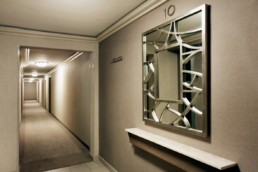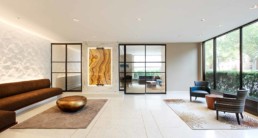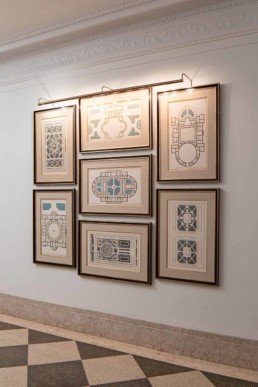How to Pick Art for a Room That Complements Your Interior Design

How do we choose the perfect art pieces for the design of this space?
I get this question a lot. With my residential clients choosing art is a piece of cake because most of them already own art they love. When more is needed I help them find pieces that fit perfectly into the spaces I’m creating for them.
But with my other clients, coop and condo residents making decisions about lobby and hallway re-dos, the process is a bit trickier. Can you imagine trying to achieve consensus on something as personal as art with a group of people who have differing tastes – and very strong opinions?
(You can view some of our recent projects and the art we chose at the end of this blog post.)
Through trial and error I have created a process that makes picking art to complement the interior design of public spaces such as lobbies and hallways, that results in gorgeous, functional rooms – and very happy residents.
Tips on How to Choose the Perfect Art Piece for Your Interior Design
Decorate around art.
Knowing how to decorate around art is an important skill to develop. For example, a wonderful painting can be the focal point around which your furniture is placed, instead of the other way around, and will help guide you in your choices of paint and accessories. Using art this way adds texture, interest, and will give your rooms a finished look.
But how to choose?
Art is everywhere and ideas are, too. Before you purchase anything, I recommend you get out there and really look at art. You might think the best place to get ideas are museums, and in New York City where I live, there’s a plethora to choose from. But museums are filled with art and nothing but art. You need to look at art where there are furniture and accessories, too.
How to decorate with art: Look for inspiration in unexpected places.
To get inspiration on art for your interior design visit places where you wouldn’t normally go specifically to look at art. For example, your favorite fine restaurant. It’s entirely possible you’ve eaten dinner fifty times at the same establishment, but never really looked at the artwork in the room.
So, make a reservation, sit down, order a glass of wine, and take a look around the room with fresh eyes. See if you can answer these questions: Why did the restaurant designer choose each particular piece? Why is it placed in that particular spot? What kind of emotion does it evoke? How does the artwork impact the room? Does it set the tone for the vibe of the restaurant? Is it disruptive – or does it harmonize with the décor?
A hotel lobby is another great place to find inspiration on decorating with art. Hotel designers invest a lot of time to select the perfect paintings, photography and sculpture. Most hotels have no problem if you want to hang out in the lobby, too.
Of course, one of the best ways to get inspiration on how to pick art for your rooms is your computer. The internet is bursting with ideas on how to choose art to enhance the décor of a room.
There are thousands of boards on Pinterest containing every type of interior design idea. In fact, my residential clients use it all the time to visualize their rooms. Some even create their own boards and share them with me. On Pinterest you’ll find images with art pieces used in every way possible – as focal points, to set the tone, to influence the arrangement of furniture, and to enhance the interior architecture.
(Another great online resource for design and art ideas is Houzz.)
It’s One of Our Most Important Skills – the Know-How to Decorate with Art
My office receives a lot of work as a New York City apartment building lobby and hallway design firm. Picking the right art is one of the most important discussions we have with our clients. We have many important decisions to make, from floor materials, to furniture, to signage – but the perfect artwork is what ties the whole design together. It’s like the bow on a gift box.
For public spaces such as the lobbies and hallways we design, there are some rules we must follow: Artwork cannot contain faces or figures. It can’t be religious or political. We stay away from edgy and extremely contemporary art. (We never want to hear “Why, I could have painted that myself!”).
We look for art that is as uncontroversial as possible. But that doesn’t mean it’s boring!
Here’s what our process of picking art looks like:
During initial meetings with our clients, we present pictures of the style of art we want to recommend. We source the web, pull tear sheets from magazines, and compile photos of some previous projects. We feel it’s very important that our clients – the people who’ll be walking through the lobby every single day, to understand our choices and appreciate the feeling we want to achieve.
Sometimes we’ll recommend art to be a focal point and use the furniture as accessories. Sometimes it’s the other way around. No two buildings are alike and no two coop/condo boards are alike, therefore, no two projects are alike.
We’ve become so good at this process that we usually get consensus pretty quickly. That’s the result of having designed hundreds of New York City lobbies!
Something that really sets us apart is the fact that we have incredible resources to work with. We have a wonderful relationship with an amazing art consultant named Marlaina Deppe of Novo Arts. Marlaina has a crew of full-time artists who can work in any style and in any medium. Whatever idea I bring to her, she can supply me with a wide selection of samples to show my clients. Over the years Marlaina’s crew has created photographs, graphics, wall sculptures, mosaics, collages, and even wood cutouts for my clients. (http://novoarts.com/)
One of my other go-to resources is a super-talented New York photographer named Alyssa Peek. Alyssa’s unique work blurs the line between art and photography. I often choose her photographs to elicit emotions such as serenity, peace, excitement, or surprise – without being overt. (http://peekphotography.nyc/peek-photo-art/)
Another resource we are lucky to have, especially for pre-war buildings and high end residential projects, is our favorite framer – J. Pocker Custom Frames & Prints. J. Pocker’s distinctive frames are works of art themselves and their craftsmanship is incomparable. They also carry a vast selection of prints in subject matter that speaks to the more traditional of our clients (see the classical landscape plans below). J. Pocker has been in business in New York City since 1926 – it’s an experience just to visit their showroom! (https://www.jpocker.com/).
Helping my clients choose the perfect art piece is truly one of the joys of being an interior designer. Art is an integral part of our designs and I’m happy to say we’ve never been called back to a building to replace the art.
I guess we’re doing something right!
Thanks for slogging through my explanation! Now enjoy some examples of how we use art in interior design projects.
Art As A Focal Point. The focal point of this doorman/concierge desk area is a painting that is geometric, vibrant, and classic. The building’s decorating committee joined me at my art consultant’s studio and made this selection. It’s an example of non-controversial (yet important) art that everyone agreed on.
Old-World Drawings. We used old-world landscape plans and had them custom sized, colored, and framed by J. Pocker (https://www.jpocker.com/). Then we had them uniquely installed to make statement in this Upper East Side pre-war lobby. This is an example of art that is non-controversial, yet really interesting.
Thank you for reading!
– Marilyn
Sygrove Interior Design Services
Sygrove Associates Design Group is an NYC interior design company. Our company’s founder Marilyn Sygrove is the lead interior designer on all projects. And she’s as tough as you are when it comes to quality, aesthetics, and coming in on time and on budget.
It all starts with a design consultation with Marilyn. She takes the time to thoroughly understand your design needs then personally directs all interior design, planning, and installation activities. Her work has been delighting clients, co-op and condo boards, and homeowners for over 30 years.
You can reach Marilyn by email at hello@sygrove.com or call her directly at 212.757.0631.
Share This Article
The Importance of a Well-Designed Concierge Desk and Station
When you live in New York City you constantly interact with doormen and concierges as you go through your day. So, when the lobby of the building you live in is inefficient, out of date, or downright drab, it has a less than joyful impact on your life. Many lobbies simply need some TLC. Some don’t fit into the architectural character of the neighborhood or even the building itself. And sometimes decisions were made during a past lobby renovation that haven’t stood the test of time.
A happy staff makes for a happy building and with that in mind, concierge desk design is an important part of what we do as part of the lobby renovation projects we take on. Residents, their guests, and the entire building staff all benefit from thoughtful lobby interior design.
We work on lobby interior design projects in New York City that include concierge desk design. Here are some examples.
Concierge Desk Design Examples We’re Proud Of.

1. 300 Riverside Drive, Manhattan
The best way to describe this lobby is “drop dead gorgeous”. However, when we first encountered it we were met by what can only be described as a dungeon. Although much of the incredible coffered ceiling, diamond patterned flooring, and Bottocino marble walls were still intact – they were hardly noticeable through the accumulated dirt and grime of past decades. Some of the tiles and architectural details were broken or missing, but there was enough in good shape that we could maintain the rich 1920’s look and feel, on which the residents insisted. And I don’t blame them. When you’re lucky enough to live in such a gem you want to celebrate it.
My team and I painstakingly considered every inch of this lobby, from ceiling to floor. The concierge desk design was inspired by one of the original pieces of lobby furniture – a console table with carved turning legs. The new desk has all the technology needed to run a modern building, yet perfectly complements the incredible architectural details of the lobby.
We are particularly proud of this project, as are the residents who enjoy it every day.
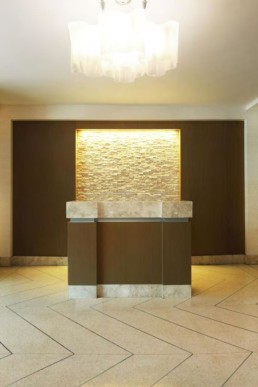
2. Briar Oaks, Riverdale
In the 1950’s New York City was experiencing a housing crisis. Newly returned GI’s were getting married by the thousands and those young couples needed apartments. Riverdale, a residential enclave in the Bronx with low population density, was a perfect spot for developers to take advantage of the demand. A building boom of high-rise apartment buildings was the result. Unfortunately, many of the structures erected during that era lack the kind of architectural detail we see in older New York neighborhoods. The lobbies, however, are often large, bright, and sometimes contain finishes that just need some TLC to bring out their luxurious character. Briar Oaks, built in 1953, has one such lobby.
The first thing I noticed about Briar Oak’s lobby was its elegant zigzag terrazzo flooring. It was definitely worth saving and was the most interesting feature. Everything we chose thereafter complements and enhances that spectacular floor – from the rich wood paneling to the luscious stone accents. The concierge desk design includes a gracefully proportioned stone top and a highly textured backdrop. The backdrop is like a piece of artwork that makes a striking contrast with the smooth and geometric lines of the floor.
The Briar Oaks lobby is truly an example of how carefully selected finishes can transform blah and boring into chic and elegant.

3. The Ellington, Manhattan
Built in 1987, The Ellington is a remarkably handsome red brick residential building that features clean, spare lines and upscale finishes. The Ellington has both a doorman station and a concierge desk, which is common in New York’s newer large apartment buildings. (The Ellington has 214 units.)
The challenge for my team was to create an elegant lobby at the same time ensure that both desk areas would hold up to the extreme wear and tear that’s common in such a large, busy building. One way we met that challenge was to source incredibly resilient materials that are at the same time elegant and luxurious. Once such material is Aquasol, a gorgeous, natural, pewter-colored stone known for its durability. We used Aquasol for both the concierge desk design and the doorman station. It will endure many years of rough treatment by strollers, shopping carts, and UPS hand trucks and still look great.

4. 50 Park Avenue, Manhattan
It was love at first sight when I walked into this lobby. It’s very unusual for a 1940’s building to have so much original wood paneling still intact. But sadly, the paneling was finished in an outdated deep red mahogany, which made the lobby feel dark and foreboding. There was no concierge desk, either. Instead, the staff used a cheesy podium, which had been purchased years earlier at an office furniture store!
Our job was to transform the lobby into a brighter, more inviting space and at the same time retain as much of the original wood paneling as we could. First, we had the dark finish stripped off to let the scrumptious beauty of the natural wood emerge. For the concierge desk design we chose a wood veneer that perfectly matches the golden hue and rich textures of the walls. It fits in so well it looks as if was original.
Today, the residents 50 Park (and their guests) are greeted by this warmth and richness every time they enter the building. They just love it!

5. 123 East 75th St., Manhattan
123 East 75th is a post-war building surrounded by Park Avenue pre-war buildings in the silk stocking district of Manhattan’s Upper East Side. We designed a new, period-inspired limestone and granite façade to give the building to better fit into the neighborhood. The owners wanted the lobby to be a continuation of that feeling. In order to make it happen, we chose rich walnut veneer and geometric lines for the lobby and concierge desk design. The result is harmony with the entrance and with the neighborhood – yet it has a clean and modern appearance.
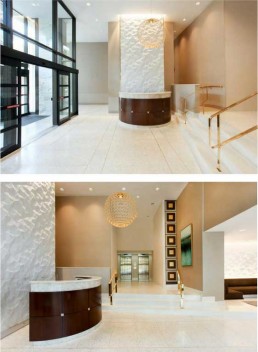
6. The Bel Air, Forest Hills, Queens
The dramatic sweeping curved lines effect of this spectacular 1965 apartment building in Queens reflects the space-age architecture of the 1964 World’s Fair. To stay true to it’s “less is more” character we made sure that the lobby remained a delightfully effortless transition from the street into the living space. We created a concierge desk design that accommodates all the new equipment the staff needs to keep the building running efficiently: Monitors, keyboard, alarms, intercom…the works! Yet it looks as if it’s always been there.
Those are just a few examples where thoughtful concierge desk design enables New York City apartment dwellers to enjoy the benefits of an elegant and well functioning lobby. You can view more photographs of our lobby interior design projects here.
Thanks for reading.
– Marilyn
Sygrove Interior Design Services
Sygrove Associates Design Group is an NYC interior design company. Our company’s founder Marilyn Sygrove is the lead interior designer on all projects. And she’s as tough as you are when it comes to quality, aesthetics, and coming in on time and on budget.
It all starts with a design consultation with Marilyn. She takes the time to thoroughly understand your design needs then personally directs all interior design, planning, and installation activities. Her work has been delighting clients, co-op and condo boards, and homeowners for over 30 years.
You can reach Marilyn by email at hello@sygrove.com or call her directly at 212.757.0631.



